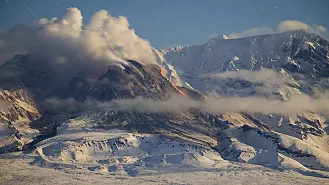A massive eruption occurred at one of the largest volcanoes on Russia’s Kamchatka Peninsula, sending ash and smoke billowing into the sky and sparking concerns about regional air quality and safety. Known for its high concentration of active volcanoes, Kamchatka is no stranger to volcanic activity, but this eruption is one of the most significant in recent years, affecting both local communities and air traffic in the region.
Details of the Eruption
The volcano, identified as Shiveluch, erupted early in the morning, spewing ash clouds up to 15 kilometers (9 miles) into the atmosphere. Russian authorities issued a red aviation alert, advising aircraft to avoid the area due to the risk of ash clouds damaging engines. Local monitoring stations have recorded seismic activity at the site for weeks, indicating that an eruption was imminent.
Impact on Local Communities
Residents in nearby towns were advised to stay indoors and wear masks if they needed to go outside. The ashfall has covered several communities in a layer of gray dust, reducing visibility and creating hazardous driving conditions. Emergency services have been dispatched to assist those affected by the eruption and to monitor any potential lava flows. Authorities are also assessing the potential impact on agriculture, as ash deposits can affect soil quality and local water sources.
Environmental Concerns
Volcanic eruptions can have significant environmental impacts, particularly when large volumes of ash and sulfur dioxide are released into the atmosphere. Ash clouds can interfere with weather patterns and, in some cases, contribute to a cooling effect on the climate by blocking sunlight. Scientists are monitoring atmospheric conditions closely to assess any long-term impacts from the eruption.
Scientific Significance
The Kamchatka Peninsula is part of the Pacific Ring of Fire, an area known for frequent volcanic and seismic activity. Shiveluch is one of the most active volcanoes in this region, and its eruptions are closely studied by volcanologists worldwide. According to Dr. Ivan Petrov, a volcanologist at the Russian Academy of Sciences, “Eruptions of this magnitude provide valuable insights into volcanic activity and help us better understand the behaviors of large stratovolcanoes.”
Global Aviation Impact
The ash cloud has already begun to disrupt regional air travel, and global aviation authorities are monitoring its spread to assess potential risks to long-distance flights. Pilots flying over the Northern Pacific have been instructed to adjust routes and remain vigilant, as volcanic ash can cause serious damage to aircraft engines and pose significant safety hazards.
Conclusion
The eruption of one of Kamchatka’s largest volcanoes serves as a stark reminder of the power of nature and the challenges that volcanic activity can pose to nearby communities, the environment, and global transportation. Authorities and scientists will continue to monitor the situation closely, providing updates as more information becomes available. The full impact of this eruption is yet to be determined, but it underscores the importance of preparedness and response in volcanically active regions.




